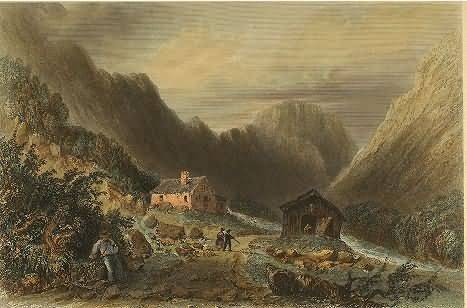Lately I’ve been obsessed with the Willey Slide — the 1826 landslide the killed the entire Willey family, innkeepers in desolate but strategic Crawford Notch in the White Mountains, leaving their house intact—now called the Willey House, in the shadow of Mount Willey. There, on one hot summer day in the 1970s, I had my first experience with that great American icon, a foot-long hot dog. Wrinkled and gamey, with both ends sticking far out the ends of a standard-sized bun, it didn’t sit well. I heard the story of the disaster with the morbid fascination of a pre-teen, and prehaps even then I was conscious of the irony of road-food as a typically inappropriate American commemoration of family tragedy. The bodies of three of the Willey children were never found.
I reconnected with the Willeys many years later, when I began to flesh out my wife’s ancestry. One New Hampshire progenitor, named Willey Hill, brought on the suspicion of a connection. His mother Mary Willey was surely from the same stock. Recently I made a concerted web-effort to pin down their Willey line. This led me not only to an apparent descent of our Mary Willey, wife of Sergeant Edward Hill and mother of Willey Hill, but also to an ancestry for her third cousin Samuel Willey, Jr.; a full narrative of the tragedy (as well as can be known, it seems); and many on-line thumbnails of the Bartlett engraving of the Willey House. Victorian New England, it seems, was just as obsessed with the pathos of this frontier drama as I was.
The best narrative of the disaster is “The Willey Slide,” by Floyd Ramsey, published in the now-defunct White Mountains literary journal Magnetic North [the article was for a while online but alas no longer]. Also, read this grim coda about the Willeys’ dog and one missing child.
It might interest some to see the Willey children’s demonstrable descent from King Edward III of England:
Descent of the Willey children (killed in a landslide in Crawford Notch, New Hampshire in 1826) via Edward Carleton, early settler of Rowley, Massachusetts, from Edward III, King of England (†1377):
1. Edward III, King of England (d. 1377) = Philippa of Hainault (d. 1369)
2. John of Gaunt, Duke of Lancaster (1340-1399) = Katherine Roet Swinford
3. Joan Beaufort (d. 1440) = Sir Robert de Ferrers (d. 1396)
4. Mary de Ferrers (d. 1458) = Sir Ralph Neville (d. 1458)
5. John Neville, Esq. (d. 1482) = Elizabeth Newmarch
6. Jane Neville = Sir William Gascoigne (d. 1464)
7. Margaret Gascoigne = Sir Christopher Ward (d. 1521)
8. Anne Ward = Sir Ralph Neville of Thornton Bridge, Yorks. ( – )
9. Katherine Neville = Sir Walter Strickland (d. 1528)
10. Walter Strickland, Esq. (d. 1569) = Agnes (Hammerton?)
11. Ellen Strickland = John Carleton of Beeford, Yorks. (d. 1623)
12. Walter Carleton (d. 1623) = Jane Gibbon ( – )
13. Edward Carleton of Rowley, Mass., 1639 = Ellen Newton
14. John Carleton (1638-1668) = Hannah Jewett (1641-after 1707)
15. Thomas Carleton (1667-1734) = Elizabeth Haseltine (1677-1758)
16. Elizabeth Carleton (1706-1773) = Jeremiah Stickney (1702-1763)
17. Anna Stickney (1741-1815) = Abiel Lovejoy (1737-1817)
18. Jeremiah Lovejoy ( – ) = Elizabeth Spring (1764 – )
19. Polly Lovejoy (1791-1826) = Samuel Willey, Jr. (1788-1826)
20. Eliza Ann Willey (1814-1826)
20. Jeremiah Willey (1815-1826)
20. Martha Glazier Willey (1816-1826)
20. Elbridge Gerry Willey (1819-1826)
20. Sally Willey (1823-1826)
Source: Weis, Ancestral Roots, line 2 (gens. 1-13). Later generations unverified, from WorldConnect.


2 Comments
Hello,
My comment is on Willey Hill. He was not a sergeant. Many records, and in fact his own grave, incorrectly list him as a sergeant in the Revolution. He was a teenager at that time and that was his only military service-he lied about his age to accompany his father. The reason for this confusion is that Willey, from Lee, and William, from Barrington (both Hills but unrelated) signed up to fight in Barrington. Both men had sons named Samuel who married women named Hannah and then moved to Barnstead. So many accounts combine the accomplishments of both men. William was, indeed, a sergeant-his gravestone is identical to that of Willey. William’s stone is at his home in Barrington, Willey’s stone is at his family’s homestead (now UNH business offices) in Lee. My husband and I try to correct this whenever we see it in print.
Thanks,
Ruby Hill
Ruby,
Thank you for your comment and correction! My principal source on Willey Hill is “Wille Hill of Durham, N.H.: a Soldier of the Revolution,” New Hampshire Genealogical Record 5.3 (1908), 97-102. This article does not make the same mistake. I may have kept ‘sergeant’ from some other source but I note that Willey’s father Edward Hill was a sergeant in the same company in which Willey served as a fifer. I was not aware of the sergeant *William* Hill with whom Willey has also been confused. My wife’s descent is through Willey Hill’s son Trueworthy Hill (b. 1799). — NLT
Post a Comment